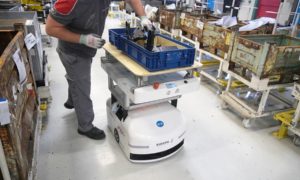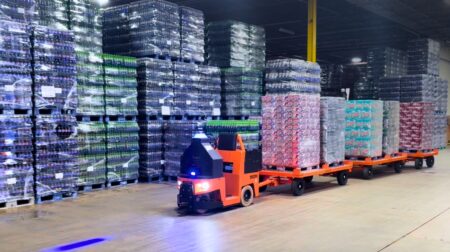A fleet of autonomous mobile robots (AMRs) by Sherpa Mobile Robots have been deployed at a FPT Industrial plant in France to co-work with humans, AGVs, forklifts and other industrial machines.
At the Bourbon-Lancy site, six Sherpa-B AMRs are used in the assembly of high-powered gas and diesel engines for agricultural machinery, buses and trucks.
Deployed in pairs to cover three assembly stations, the AMRs work across motor supports, motor flywheels and basins. At the robot’s departure point an operator prepares the parts. Then, when the mobile robot arrives at the assembly line, another operator receives the parts.
The AMRs have three programmed missions for each assembly station. Each robot brings a prepared and assembled sub-assembly from the preparation area to the assembly area and then returns.

Central to this organisation is line-side management, which is both automated and mobile. The operators stay within their work area as the AMRs come to them, carrying parts and specific tools.
Damien Winling, technical director at Sherpa, said: “The robot arrives at the right time with the right part.
“Using this fleet makes assembly tasks less arduous and reduces the risks associated with transporting loads. Because the flow is managed more smoothly, this increases productivity.”
The AMRs are used 20 hours a day, with a total of 450 robot missions carried out daily. Each AMR features a lidar system as well as safety sensors to detect obstacles on the ground. Sensitive edges stop the AMR if it touches an obstruction.
Furthermore, Sherpa has developed its own fleet management system (FMS), which offers a mapped view of the work area to show the robots’ movements with mission indicators such as time, movement and charge.
A Shercom module indicates the traffic in the area of the AMRs, with the FMS managing the sequence of the robots, including the ability to put them on hold in a dedicated area.
Winling added: “Integrating these six robots has allowed us to acquire substantial experience of fleet management in an existing environment. We will be able to deploy these new skills at other customers looking for this type of technology.”








